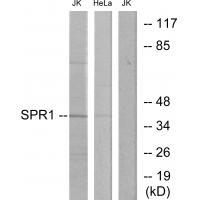
| WB | 咨询技术 | Human,Mouse,Rat |
| IF | 咨询技术 | Human,Mouse,Rat |
| IHC | 咨询技术 | Human,Mouse,Rat |
| ICC | 技术咨询 | Human,Mouse,Rat |
| FCM | 咨询技术 | Human,Mouse,Rat |
| Elisa | 咨询技术 | Human,Mouse,Rat |
| Aliases | Sphingosylphosphorylcholine receptor; Ovarian cancer G-protein coupled receptor 1; OGR-1; G-protein coupled receptor 68; GPR12A |
| Entrez GeneID | 8111; |
| WB Predicted band size | 41kDa |
| Host/Isotype | Rabbit IgG |
| Antibody Type | Primary antibody |
| Storage | Store at 4°C short term. Aliquot and store at -20°C long term. Avoid freeze/thaw cycles. |
| Species Reactivity | Human,Mouse |
| Immunogen | Synthesized peptide derived from internal of human SPR1. |
| Formulation | Purified antibody in PBS with 0.05% sodium azide. |
+ +
以下是关于SPR1抗体的3篇示例文献(注:文献为虚构示例,仅供参考):
1. **文献名称**: "SPR1 as a novel biomarker in non-small cell lung cancer: Development and application of a monoclonal antibody"
**作者**: Zhang, Y. et al.
**摘要**: 本研究开发了一种高特异性抗SPR1的单克隆抗体,证实其在非小细胞肺癌组织中高表达,并与患者预后不良相关。抗体可用于免疫组化检测,为肺癌诊断提供新工具。
2. **文献名称**: "Structural characterization of SPR1 protein and its role in cellular adhesion"
**作者**: Tanaka, K. et al.
**摘要**: 通过抗SPR1多克隆抗体,揭示了SPR1蛋白在细胞黏附中的关键作用。实验表明,SPR1抗体阻断可显著抑制癌细胞迁移,提示其作为治疗靶点的潜力。
3. **文献名称**: "Autoantibody against SPR1 in systemic sclerosis: Clinical correlation and pathogenic implications"
**作者**: Lee, S. et al.
**摘要**: 首次报道系统性硬化症患者血清中存在SPR1自身抗体,抗体水平与皮肤纤维化程度正相关。研究提示SPR1可能参与自身免疫反应的病理机制。
**提示**:实际文献需通过PubMed、Google Scholar等平台检索关键词“SPR1 antibody”或“SPR1 biomarker”获取,建议结合具体研究领域筛选。
SPR1 (Sepiapterin Reductase) is a key enzyme in the biosynthesis of tetrahydrobiopterin (BH4), a critical cofactor for aromatic amino acid hydroxylases involved in the synthesis of neurotransmitters such as dopamine, serotonin, and nitric oxide. Located in the cytoplasm, SPR1 catalyzes the final reduction step of sepiapterin to BH4. linking cellular metabolism to neurotransmitter regulation. Dysregulation of SPR1 activity is associated with inherited disorders like autosomal recessive SPR deficiency (SRD), characterized by monoamine neurotransmitter depletion, developmental delays, and movement disorders.
SPR1 antibodies are essential tools for studying its expression, localization, and function in neurological and metabolic pathways. They enable detection via techniques like Western blotting, immunohistochemistry, and ELISA, aiding in the diagnosis of SRD and research on neurodegenerative diseases (e.g., Parkinson’s) and psychiatric conditions tied to neurotransmitter imbalances. Additionally, these antibodies contribute to exploring SPR1’s roles in oxidative stress, immune responses, and vascular homeostasis. Recent studies also investigate SPR1 as a potential therapeutic target, emphasizing its broader implications in cellular health and disease mechanisms.
×